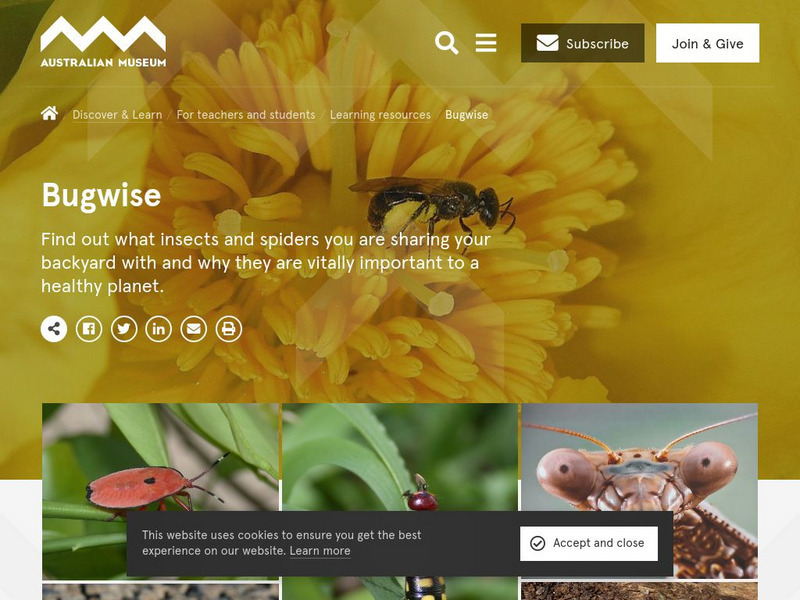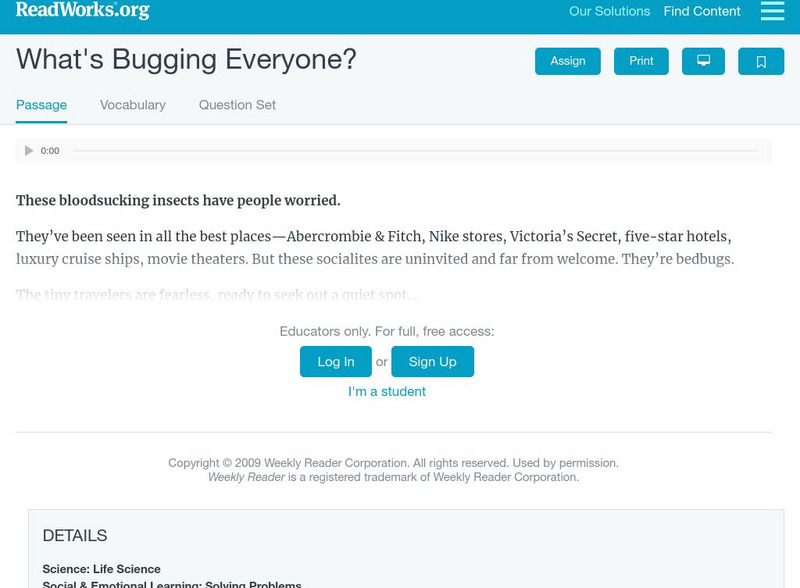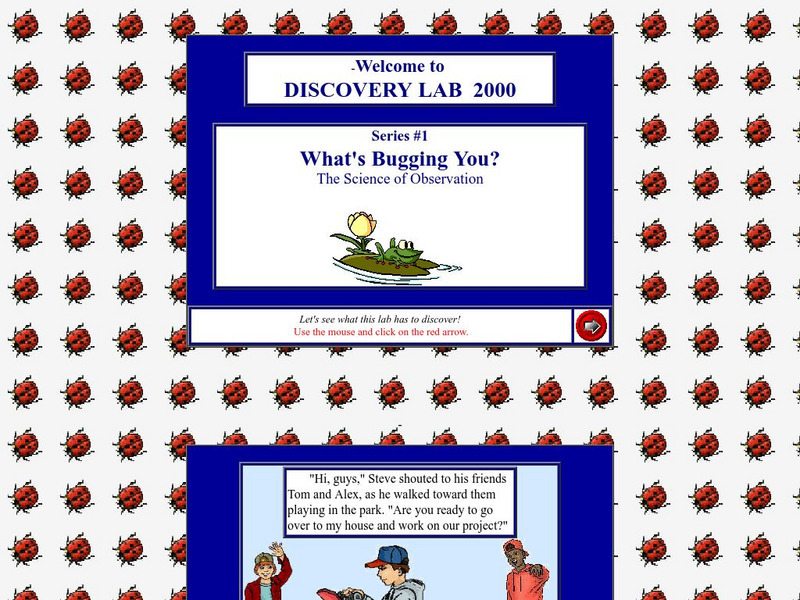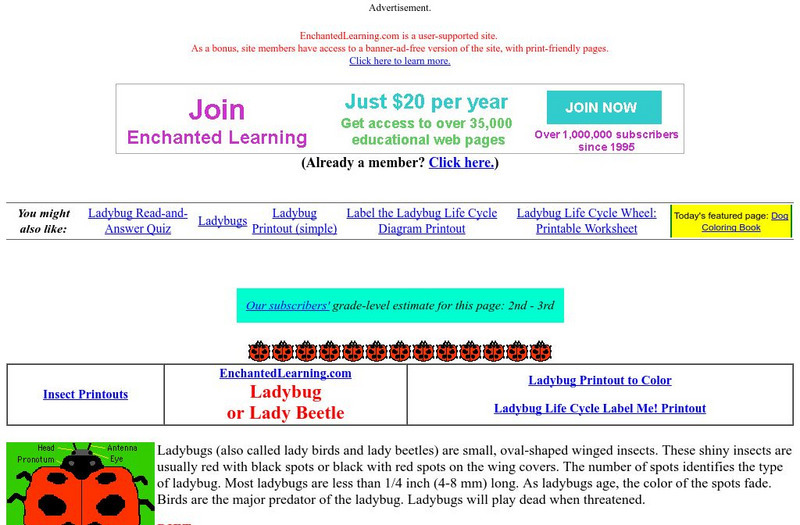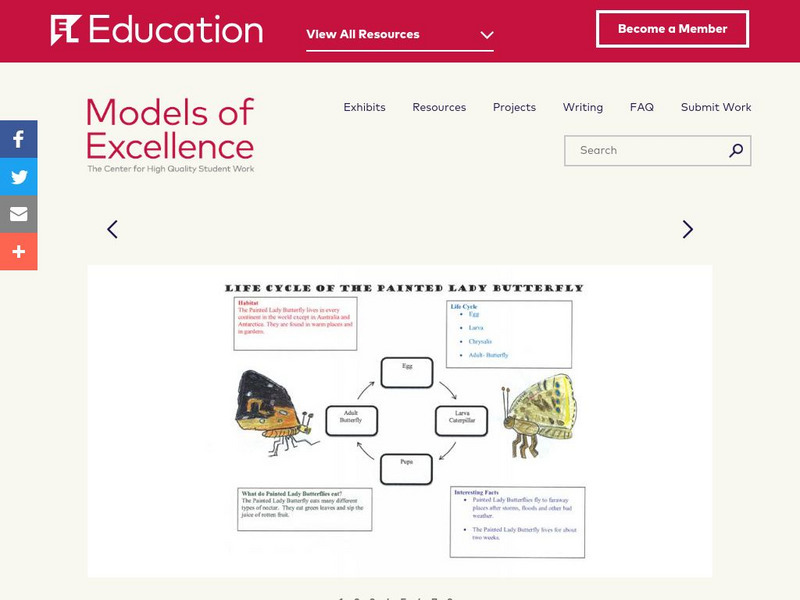Iowa State University
Iowa State University: Iowa Insect Information Notes Flies
Flies are almost always known as pests, especially the types called gnats that bite! These information sheets provide descriptions of several types of flies as well as life cycles and ways to reduce these annoying bugs.
Other
Cindy Mark: What's Bug'n You
Students will enjoy learning more about bugs in this engaging resource. Allows users to draw a picture of a spider, create an insect information book, discover how insects move and be able to tell where insects live.
Other
Amateur Entomologists' Society: Bug Identification
This resource allows users to complete bug identification.
National Pest Managment Association
Pest World for Kids: Pest Guide: Bed Bugs
A one-page fact page about the bed bug.
University of Oxford (UK)
Oxford University Museum of Natural History: Insects
Flies, fleas, beetles and bees are all insects, and the study of insects is called entomology. Insects are probably the most important group of animals on earth - there may be as many as ten million different types of insect alive today!...
Australian Museum
Australian Museum: Bug Wise
Explore the diverse world of invertebrates. Learn what they are, what they do, and how they contribute to our planet. This site offers "BugWise News", a forum, an invertebrate guide, and a wide range of great resources and activities.
Read Works
Read Works: What's Bugging Everyone?
[Free Registration/Login Required] An informational text about bedbugs and how difficult they are to exterminate. A question sheet is available to help students build skills in reading comprehension.
Beacon Learning Center
Beacon Learning Center: What's Buggin' You?
Become a scientist for the day and use the science of observation to join forces with Professor Mill Ennium in the Discovery Lab. Help them to uncover the identity of the mystery bug.
PBS
Nova: Bitten by the Bug
Peter Tyson explains the reasons he finds amber fossils so interesting. Read his descriptions and catch his passion for these fossils.
University of Kentucky
University of Kentucky: Bug Fun
This fun site is designed for teachers who want to have interactive fun in the classroom. "Several articles give resources and basic information about insects and their relatives while others outline activities with different insect...
FT Exploring
Ft Exploring: Ants: Super Bugs
Discover how these small insects can really be super bugs. Site uncovers some interesting facts as well as dispels some myths about them. Visit this site and discover the real truth.
Curated OER
Kids Health: Hey! A Bed Bug Bit Me
Use this site to find out what a bedbug is, what it looks like, and why it would want to bite you at this site from Kids Health. You'll also learn ways to avoid bedbug bites and what you should do if you do get bitten.
Ed Koday
Web Archive: Stink Bugs
Several of the common species of stinkbugs found in the United States are the southern green stinkbug, the green stinkbug, and the brown stinkbug. The green stinkbug is similar to the southern green stinkbug shown in the photo. At times...
Other
Bugbios: Class Insecta
See pictures of many different butterfly wing patterns and read about the individual butterflies.
Enchanted Learning
Enchanted Learning: Ladybug or Lady Beetle
This site from Enchanted Learning provides detailed information on lady bugs and how they can help your garden grow. Includes printouts for labeling and coloring.
My Learning
My Learning: Minibeasts
All you need for an in-depth study of invertebrates is here on this site. Includes worksheets, quiz, useful information, and a fun interactive section where you can build your own super bug!
Other
Bug Bios: Arthropods Values and Perceptions
A scholarly article which discusses the effects that arthropods have had on human beings over the years, from being a food source to a carrier of many human diseases.
Curated OER
Kids Health: Hey! A Gnat Bit Me
This site is provided for by Kids Health. Gnats, or blackflies, are very small insects. Their reason for biting is to get blood. Use this site to find out more about gnats, and how to handle a bite from one.
Curated OER
Kids Health: Hey! A Chigger Bit Me
This site is provided for by Kids Health. Did you realize that chiggers are so small that they can actually be found on other bugs? They are a type of mite, which means they are an arachnid. What happens when you're bitten by a chigger?...
Smithsonian Institution
Smithsonian: Science Fair Projects, Suggestions
A concise page that offers a number of bug-related science fair project suggestions.
EL Education
El Education: The Study of Life Cycles
Students learn about various insects and use original text and illustrations to create a book including information such as habitat, life cycle, diet, behavior, predators, and other interesting facts.
Other
National Integrated Pest Management Network
This site shows general info on IPM, but allows you to get specific by picking a pest or a commodity.
Utah Education Network
Uen: Macroinvertebrate Mix and Match
Activity explores major segments of aquatic macroinvertebrates and differences between stages.
Ed Koday
Web Archive: Green June Beetle
The adult green June beetle (family Scarabaeidae) is usually 3/4" to 1" long, and 1/2" wide. The top side is forest green, with or without lengthwise tan stripes on the wings. The underside is metallic bright green or gold, and has legs...
Other popular searches
- Insects and Bugs
- Bugs and Insects Crafts
- Bugs and Insects Art
- Insects and Bugs Stencils
- Theme Insects and Bugs
- Bugs and Insects Prue School
- Studying Bugs and Insects
- Bugs and Insects Pre School
- Bugs and Insects Worksheet
- Bugs or Insects Anatomy
- Insects, Lightning Bugs
- Bugs Insects Free







